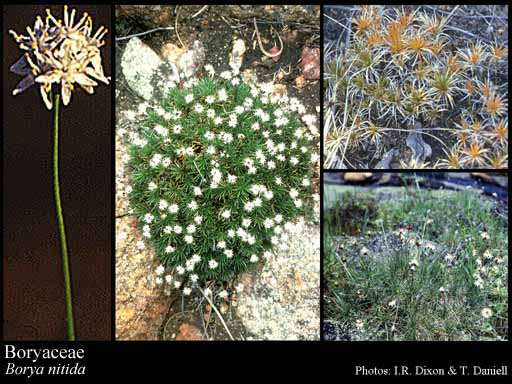- Reference
- Kew Bull. 52:416 (1997)
- Name Status
- Current

Scientific Description
Family Sometimes included in Liliaceae, Anthericaceae.
Habit and leaf form. Shrubs (subshrubs), or herbs. Herbs perennial (able to aestivate). Leaves cauline. Rhizomatous (tussocky or with a creeping rhizome, with mycorrhizal roots). Leaves alternate (‘indeterminate’, crowded at the apex of stems or branches, or secund); spiral, or distichous; leathery; sessile; sheathing. Leaf sheaths not tubular; with free margins. Leaves edgewise to the stem, or with ‘normal’ orientation; simple. Leaf blades entire; linear; parallel-veined; without cross-venules; persistent, upper part lamina-like, lower part sheathing, articulate or not articulate near the base. Leaves ligulate, or eligulate; without stipules. Leaf blade margins entire. Leaf anatomy. Extra-floral nectaries absent. Stem anatomy. Secondary thickening absent.
Reproductive type, pollination. Fertile flowers hermaphrodite. Unisexual flowers absent. Plants hermaphrodite. Floral nectaries present. Nectar secretion from the gynoecium (from septal nectaries). Entomophilous (flies).
Inflorescence and flower features. Flowers aggregated in ‘inflorescences’; in spikes. The terminal inflorescence unit cymose, or racemose. Inflorescences scapiflorous; terminal, or axillary; compressed, head-like or umbel-like; with involucral bracts (outer bracts subulate and inner bracts scale-like in Borya), or without involucral bracts (Alania). Flowers bracteate. Bracts imbricate. Flowers bracteolate. Bracteoles enfolding the perianth tube. Flowers small, or medium-sized; regular; 3 merous; cyclic; pentacyclic, or tetracyclic. Perigone tube present. Perianth of ‘tepals’; 6; 2 -whorled (3+3); isomerous; joined (tubular to top of floral bracts in Borya, almost free in Alania); petaloid; similar in the two whorls; white to cream; persistent. Androecial members definite in number. Androecium 6. Androecial members adnate (at throat or base of perianth tube); all equal; free of one another; 1 -whorled, or 2 -whorled. Stamens 6; all more or less similar in shape; diplostemonous. Filaments glabrous. Anthers basifixed; dehiscing via longitudinal slits; latrorse, or introrse; tetrasporangiate. Gynoecium 3 carpelled. The pistil 3 celled. Carpels isomerous with the perianth. Gynoecium syncarpous; eu-syncarpous; superior. Ovary plurilocular; 3 locular; sessile. Gynoecium stylate. Styles 1; simple; apical. Stigmas 1; 1 - lobed; capitate. Placentation axile. Ovules 2–3 per locule (Alania), or 15–50 per locule (i.e. many, in Borya); in 2 rows; non-arillate; campylotropous, or anatropous.
Fruit and seed features. Fruit non-fleshy; dehiscent; a capsule (surrounded by persistent bracts and perianth). Capsules loculicidal. Fruit 3 celled; 1–4 seeded. Seeds rounded to ovate; endospermic. Cotyledons 1. Embryo straight to curved. Testa smooth, or with tubercles.
Geography, cytology, number of species. Native of Australia. Endemic to Australia. Australian states and territories: Western Australia, Northern Territory, Queensland, and Victoria. Northern Botanical Province and South-West Botanical Province. X = 11 or 14.